Summary
The article describes a troubleshooting process for a client’s Siemens Gigaset DECT base stations and handsets. The problem was intermittent issues with connection quality and some handsets not ringing during incoming calls. The article details the steps taken to investigate the issue, including updating firmware, disabling information services, and monitoring the RF spectrum. After ruling out network and firmware issues, the technicians discovered that the two base stations were placed too close to each other, causing interference. The article suggests using a DECT Multi-Cell solution, such as a Gigaset N870 base station, to avoid similar issues in the future.
Recently we ran into a problem at a client who operates 2 Siemens Gigaset DECT base stations (N510 IP Pro) with 4 VoIP channels per base station and 8 DECT handsets (SL750H Pro and SL800H Pro), 4 handsets per base station. All devices are from the Gigaset Pro series.
Problem description
The issue was that there were intermittent problems with the connection quality, usually this has to do with a VoIP traffic on the network layer or codec problems. e.g. Packetloss, wrong QoS settings or some other network mis-configuration which has a negative impact on VoIP/SIP/RTP traffic.
Secondly it sometimes happened that one or more handsets did not ring during in incoming call.
Previous efforts to resolve the issue
In this case network problems were previously ruled out by double checking the VoIP priority (QoS) in the local router and monitoring the network connectivity (business fiber internet) from the WAN and the LAN side. Also multiple VoIP codecs where used and they all resulted in the same intermittent interference. A base station had also been replaced since it caused other issues (the base station restarted intermittently).
Investigation on-site
We started by update the firmware on all handsets, 3 of the 8 handsets where not using the latest firmware.
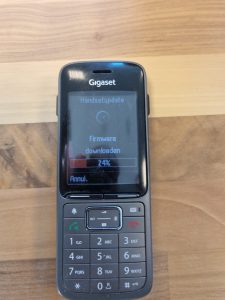
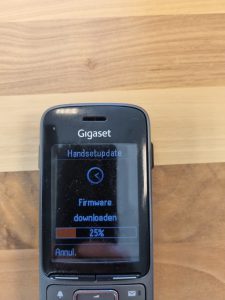
Secondly we disabled all information services and “tickers” on screen to make sure that the DECT channels were not used to send unnecessary data traffic (weather information etc) which could block one or more DECT channels while VoIP traffic should have priority. These tickers can cause a base station to send “Busy here” for a handset during an incoming call and therefore blocking VoIP traffic due to the fact that the phone is busy with data fetching.
After the update was completed we gathered all phones for some testing.
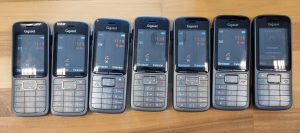
We started this investigation by monitoring the RF spectrum at the client within the DECT RF range (1880-1900MHz EU Range)
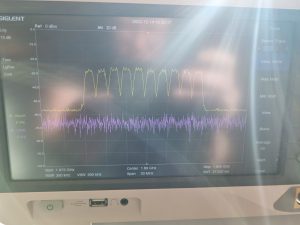
(See the following links for more information on DECT: https://www.dect.org/dect-technology / https://en.wikipedia.org/wiki/Digital_enhanced_cordless_telecommunications)
Spectrum where all 10 DECT channels have been active.
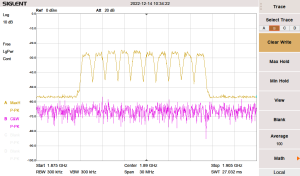
Spectrum with 3 active channels
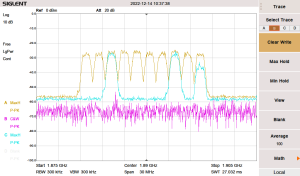
The spectrum looked clean, unoccupied and no in-band interference was detected.
We continued to monitor the spectrum during testing to make sure there was no intermittent RF interference.
We were able to reproduce the problem by calling the client’s VoIP Line (eight phones start ringing), picking up this call (So far so good and no problems), and setting up a second incoming call.
As soon as the second call is setup on a different phone the first caller hears a strong noise (sounding like purple noise) . Strangely the person who took the first call does not hear any interference. So it seems that the receiver of the DECT signal (the base station) does something with the audio/DECT decoding which causes the malformed audio.
Furthermore the 2nd caller and the person who picks up the second call have no issues whatsoever with their call.
Both calls where handled by the same base station and the second base station successfully made all phones ring (in total 8 phones rang on the first incoming call, all 7 remaining phones rang on the second incoming call).
We’ve gone over this procedure over 5 times with 100% hit rate on what the client described to be happening when they have an issue.
Since we could not find a problem in the RF space (no external interference) and a VoIP/network issue was already ruled out we looked at the physical setup of both base stations.
They were setup on top of a metal network cabinet standing 30 cm apart from each other.
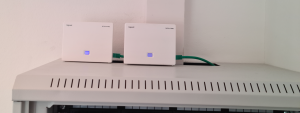
To rule out RF interference caused by the base stations themselves we moved one base station to a separate location in the building (over 7 meters away from it’s initial place). After moving the base station we stared the same procedure by setting up 2 calls and try to reproduce the issue.
The issue was gone, we did some further testing and where unable to reproduce any problems which we previously experienced with a 100% hit rate.
Both base stations send out the ring signal to all phones at full power, it is possible that they accidentally overlap on one or more DECT channels, but we did not see this on the spectrum during an incoming call. What we think happened is that the radio chip in the N510 hasn’t got enough dynamic range or blocking capacity for strong adjacent signals overdriving the receiver and causing these problems.
We couldn’t find any reference in the manual of the base station which stated that you shouldn’t place 2 base station near each other or any other form of physical installation guideline/restriction. But as with a lot of RF systems using the same frequency/channels it seems that the DECT radio’s used in these systems are unable to cope with strong adjacent signals from a separate source.
The lessons we took from this experience is that we shouldn’t allow 2 base stations to be setup in close proximity and furthermore there is a better solution available by using a DECT Multi-Cell solution like a Gigaset N870 base station. With the Multi-Cell solution all phones can be paired to a single base station and there are enough VoIP and DECT channels available to provide all 8 phones with a VoIP line and DECT channel simultaneously.
Final notes
After we completed the testing we saw something we could not explain on site but luckily did not interfere with DECT traffic:
Spectrum with unknown interference on the left side.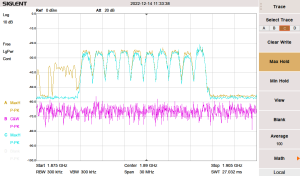
Update 1 (2022/12/15)
One of our readers mentioned that unlike the N510, the N870 does come with a recommendation for installation incl. the distance between 2 DECT base stations. This is mentioned in a separate technical document named:
“N870 IP PRO
Multicell System
Site Planning and Measurement Guide”
Here is a snippet from this document.

Sadly this critical piece of information is not to be found in the installation manual of the N870 or the N510.
Since N510 base stations are mostly installed by the end user themselves and not by a trained technician, it would be great if this can be added to the basic manual, and perhaps even with a reference to the “Site planning and measurement guide” just like Siemens did in the N870 manual.
*let op onderstaande links betreffen affilate links naar Amazon.
DECT – RF – Interferrentie – Storing – twee basisstations op de zelfde locatie – Siemens Gigaset – N510 IP Pro – SL750H – SL800H Pro – Siglent SSA3021X Plus
